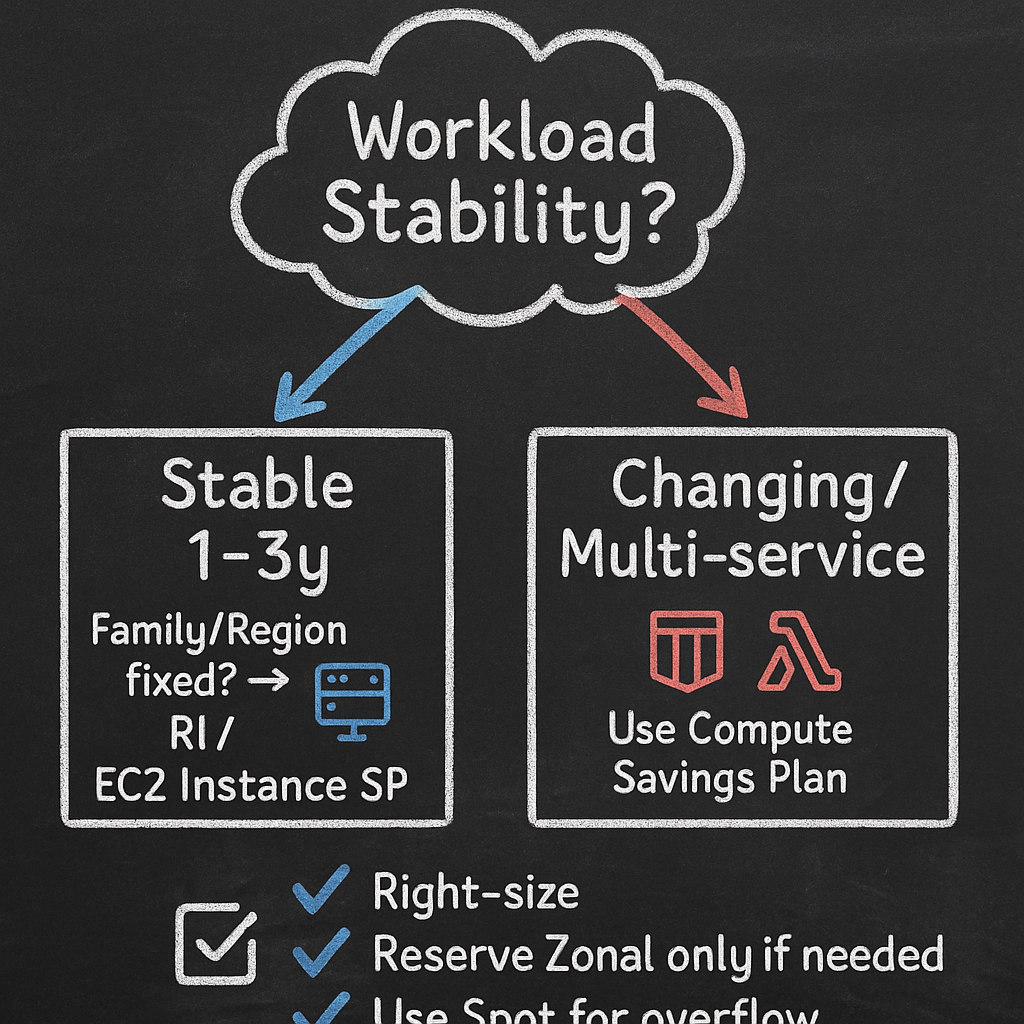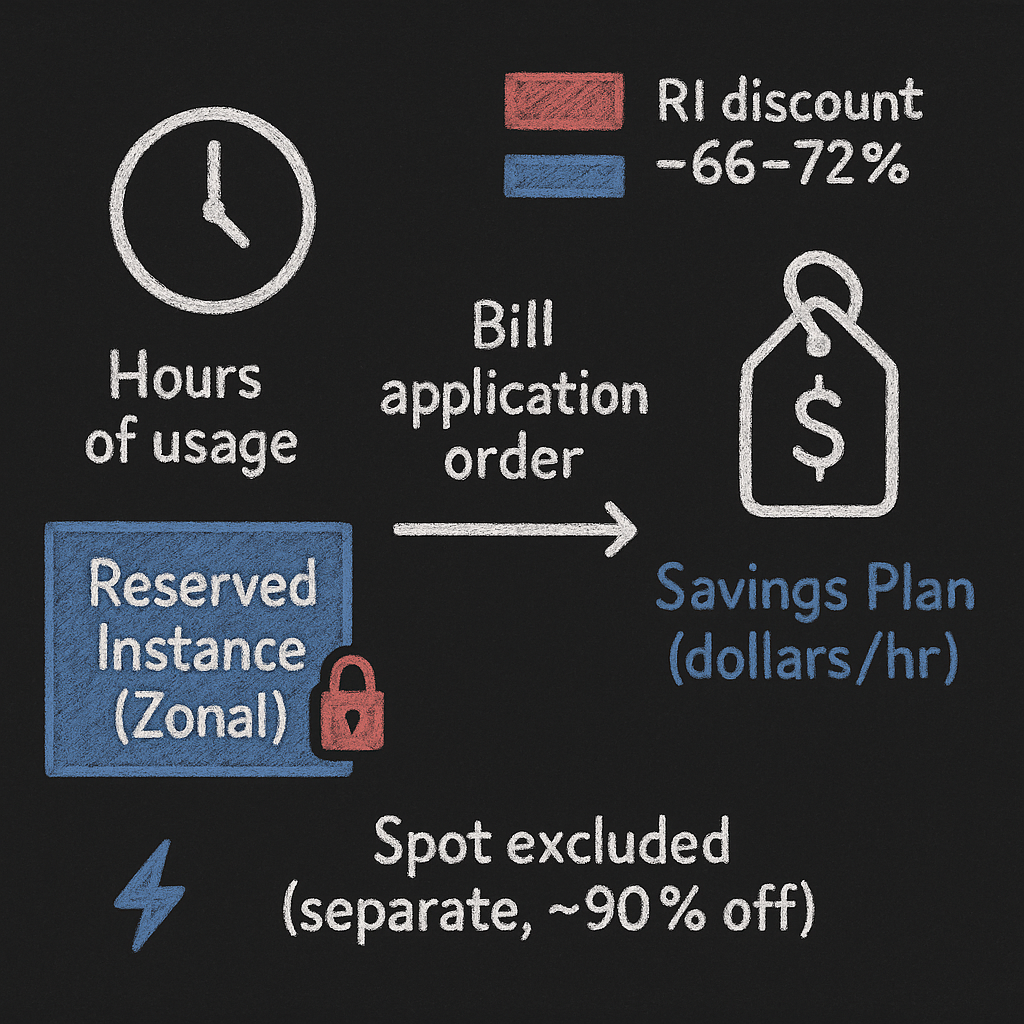EC2 savings plans vs. reserved instances: a practical, data-driven decision guide
Want EC2 savings without performance surprises? The biggest lever isn’t picking the “right” discount model—it’s aligning commitments to how your workloads actually run. Here’s a clear way to choose between Savings Plans and Reserved Instances (RIs), with rules of thumb, examples, and pitfalls to avoid.
Quick definitions
AWS Savings Plans are commitment-based discount programs where you agree to a specific dollars-per-hour spend for 1 or 3 years. In exchange, you receive discounted rates that automatically apply to eligible usage. Compute Savings Plans offer flexibility across EC2, Fargate, and Lambda in any region, family, size, OS, or tenancy. EC2 Instance Savings Plans commit to a specific EC2 family per region for higher discounts. Depending on term and payment options, savings can reach up to 72% versus On-Demand pricing.
AWS Reserved Instances require committing to capacity for a specific scope (regional or zonal), instance attributes (type/family, OS, tenancy), and term (1 or 3 years) in exchange for a discount. Standard RIs deliver the highest discount with the least flexibility, while Convertible RIs allow changes with somewhat lower discounts. Most sources cite up to 72% off On-Demand rates, though Hykell has observed up to 75% savings on certain Standard RIs.
Neither Savings Plans nor RIs discount Spot usage, as Spot already includes steep discounts (often up to 90%) and is billed separately.

How the discounts apply on your bill
Savings Plans discount your committed spend rate (dollars per hour), while RIs discount reserved capacity (hours of instance usage). When both apply, AWS applies RI coverage first, then Savings Plan discounts to the remaining eligible usage.

Both mechanisms can work across linked accounts via AWS Organizations consolidated billing, providing enterprise-wide coverage for your committed resources.
Key differences that impact your choice
Flexibility
Compute Savings Plans offer maximum flexibility across regions, families, sizes, OS, and tenancy—ideal when environments evolve or you’re adopting multiple compute services. Standard RIs are rigid in comparison, while Convertible RIs provide more flexibility but typically at lower discount rates.
Scope and services
Savings Plans cover EC2, Fargate, and Lambda (for Compute SP), or are limited to specific EC2 families (for EC2 Instance SP). Reserved Instances primarily cover EC2, though reservation-style commitments also exist for RDS, ElastiCache, Redshift, OpenSearch, and DynamoDB.
Capacity reservation
One crucial difference is that Zonal RIs reserve actual capacity in an Availability Zone—critical for strict capacity guarantees. Savings Plans, by contrast, only discount usage without guaranteeing resource availability.
Automated coverage
Savings Plans automatically apply to wherever eligible usage appears, making them easier to manage. RIs require more active planning and management to avoid underutilization and wasted spend.
Resale and changes
Standard RIs can be listed on the AWS Reserved Instance Marketplace if your needs change, while Savings Plans cannot be resold. Convertible RIs can be exchanged within certain rules, but Savings Plans cannot be modified after purchase (though you can purchase additional plans).
Maximum savings potential
Both Savings Plans and RIs typically top out around 66–72% off On-Demand prices. Standard RIs can sometimes exceed that percentage depending on the specific SKU and payment choice.
Clear decision rules for EC2
Use this mental model: Start with workload stability, then decide on flexibility requirements, then layer in capacity needs.
Are your EC2 workloads steady and predictable for 1–3 years? If yes, and you need maximum flexibility across regions/families, choose a Compute Savings Plan. You’ll get near-RI savings with less management overhead. If your usage is locked to a specific family/region, an EC2 Instance Savings Plan or Standard RI might be better. EC2 Instance SPs often get within a few percentage points of Standard RI savings but remain easier to manage.
Do you need guaranteed capacity in a specific AZ? Choose Zonal Standard RIs for capacity reservation. This is the primary advantage RIs have that Savings Plans cannot provide.
Is your environment changing through new services, container adoption, or region moves? Prefer Compute Savings Plans to avoid stranded commitments. They follow your usage automatically across EC2, Fargate, and Lambda.
Do you value resale optionality? Standard RIs can be sold on the Marketplace if your plans change, while Savings Plans cannot be resold.
Are your workloads time-bound but predictable (e.g., nightly batches)? Consider Scheduled RIs for deterministic windows, though they’re narrower in fit and relatively management-heavy.
Rule of thumb for 2025: Most organizations should favor Savings Plans for similar discounts with far better flexibility and simpler operations. Only choose RIs when you need zonal capacity reservation or when a tightly scoped, unchanging workload can justify a slightly higher discount and the additional management overhead.
Concrete examples to make it real
A fast-growing SaaS platform on EKS and Lambda will see workloads shift across EC2 node types, Fargate tasks, and Lambda functions. A 3-year Compute Savings Plan smooths discounts as usage evolves without requiring micromanagement of instance coverage.
For a steady analytics cluster in us-east-1 on the m7i family, if you won’t change families for 3 years, an EC2 Instance Savings Plan or Standard RI for m7i in that region can maximize savings. Choose Zonal RIs only if you require capacity guarantees for batch SLAs.
Retail events with strict windowed capacity needs (like Black Friday) may require guaranteed capacity in a specific availability zone for legacy applications. Zonal Standard RIs provide both reservation and discount benefits. Use On-Demand or Spot for overflow; Savings Plans won’t reserve capacity.
When replatforming from Windows to Linux, Convertible RIs can accommodate OS and family changes but at lower discounts. A Compute Savings Plan may be simpler and just as effective throughout the transition.
How much can you actually save?
Savings Plans typically offer up to 72% discount depending on type, term, and payment options. Compute SPs usually cap lower than EC2 Instance SPs. Reserved Instances are commonly quoted up to 72% savings, though Hykell has observed Standard RIs reaching up to 75% in specific cases.
Important: discounts only matter for utilized coverage. Underutilized RIs or oversized Savings Plan commitments convert “savings” into wasted spend.
The biggest lever before you commit: right-size first
Right-sizing is the single most effective optimization technique. Hykell has found more than 40% of EC2 instances run under 10% CPU even at peak, and right-sizing can cut EC2 costs by approximately 35% with no performance impact. The recommendation is clear: right-size first, then set your Savings Plans/RIs commitment level to match the new, lower baseline.
While optimizing, don’t forget storage waste and volume modernization:
- Migrate gp2 to gp3 volumes for better price/performance ratio, and delete obsolete EBS snapshots
- For performance-sensitive storage, follow Amazon EBS best practices to avoid overprovisioning IOPS
Disadvantages and risks to watch
With Reserved Instances, you risk underutilization if you change instance families/regions or scale down. You pay regardless of use. There’s also more operational overhead to right-size coverage and track drift across accounts and regions. Liquidity is limited to Marketplace-eligible Standard RIs; not all positions can be sold.
Savings Plans lack capacity reservation; during rare supply constraints, you get discounts but not guaranteed capacity. Commit-level sizing matters—overcommitting locks you into spend you must “fill” with usage to avoid waste.
How Savings Plans and RIs interact with Spot
Spot instances operate on a separate discount mechanism. Neither RIs nor Savings Plans apply to Spot usage because Spot already carries its own discount (often up to 90%) and can be interrupted on short notice. Use Spot for stateless, fault-tolerant workloads, and reserve Savings Plans/RIs for your steady baseline.
What about AWS EDP vs. Savings Plans/RIs?
The AWS Enterprise Discount Program (also called a Private Pricing Agreement) is a broader, contract-based discount across many services, typically for organizations with $1M+ annual spend. It complements—not replaces—Savings Plans/RIs. Many enterprises use an EDP plus Savings Plans to stack predictable savings with flexibility.
A simple 5-step selection checklist
- Benchmark stability: Identify your steady 12–36 month EC2 baseline after right-sizing
- Choose flexibility first: If you expect changes in families/regions or are adopting Fargate/Lambda, prioritize a Compute Savings Plan
- Reserve capacity only if needed: Use Zonal Standard RIs for strict AZ capacity guarantees
- Fill the edges with Spot: For bursty, interruptible portions, deploy Spot and autoscaling
- Monitor and iterate quarterly: Track coverage, utilization, and service mix; adjust with additional Savings Plans or RI exchanges as needed
For broader context on trade-offs across clouds, see our guide to GCP vs AWS cost. And if performance is a concern as you optimize, this AWS vs Azure performance comparison breaks down compute and storage nuances.
FAQs at a glance
Which is better: RIs or Savings Plans?
For most teams in 2025, Savings Plans win on flexibility while offering similar discounts. Choose RIs primarily for zonal capacity reservation or highly static, scoped fleets.
What are the disadvantages of RIs?
Potential underutilization, higher management overhead, rigidity across families/regions, and limited resale options depending on SKU and term.
How do Savings Plans differ from Spot?
Savings Plans discount steady usage but don’t interrupt workloads. Spot is deeply discounted but interruptible, and these discounts don’t stack.
How much do you save with RIs?
Often up to 72% vs On-Demand; specific SKUs can exceed that for Standard RIs.
What are RI and SP in AWS?
RIs = Reserved Instances; SP = Savings Plans. Both are commitment-based discounts for compute.
What are the types of Savings Plans?
Compute Savings Plans (broadest coverage) and EC2 Instance Savings Plans (higher discount but family/region scoped).
Make savings automatic without the performance trade-offs
If you want the savings without spreadsheet wrangling, Hykell can help you right-size, pick the optimal Savings Plan/RI mix, and monitor utilization in real time—on autopilot. Most clients cut AWS costs by up to 40% while maintaining or improving performance, and you only pay a share of what you save. Explore our AWS cost management best practices or see how our Cost Optimization Hub surfaces dollar-impacting actions automatically.
